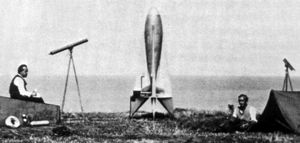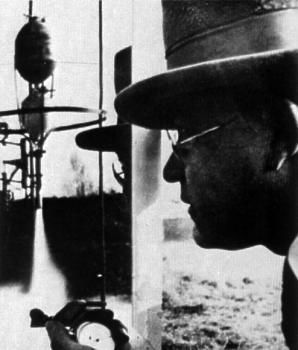Winkler (original) (raw)

Home - Search - Browse - Alphabetic Index: 0- 1- 2- 3- 4- 5- 6- 7- 8- 9
A- B- C- D- E- F- G- H- I- J- K- L- M- N- O- P- Q- R- S- T- U- V- W- X- Y- Z
Winkler, Johannes
German engineer. Rocket enthusiast, launched first liquid rocket in Europe on 1931.02.21.
Born: 1897-05-29. Died: 1947-12-27. Birth Place: Bad Karlsruhe.
After completing gymnasium in Liegnitz, Winkler enlisted in the army. He was severely wounded at the Battle of Lake Narocz in 1916. After seven months in the hospital, he attended the Technische Hochschule in Danzig, graduating with a degree in mechanical engineering in May 1918. While working as an engineer for Junkers Aircraft in Breslau, Winkler became seriously fascinated with Oberth's calculations proving the feasibility of manned space travel using liquid propellant rockets. Winkler founded the pioneering Society for Space Travel (Verein fur Raumschiffarht - VfR) and became its first president. From 1927 to late 1929, he was the editor and publisher of The Rocket (Die Rakete), the first journal of rocketry and astronautics. He quit his job at Junkers and built and flew the first liquid propellant rocket in Germany in 1931. After the failure of his HW-2 rocket he returned to his old job at Junkers, and then worked for the government Luftforschungsanstalt (Aeronautical Research Institute) during World War II. Although he designed a number of JATO units and sounding rockets, none were ever put into production. He died at Braunschweig-Querum on 27 December 1947.
Country: Germany. Launch Vehicles: HW-1, HW-2. Agency: Wehrmacht. Bibliography: 378, 6216.
Photo Gallery
 |
Winkler and HW-2 |
|---|
 |
HW-2 |
|---|
1897 May 29 - .
- Birth of Johannes Winkler - . Nation: Germany. Related Persons: Winkler. German engineer. Rocket enthusiast, launched first liquid rocket in Europe on 1931.02.21..
1927 June 5 - . Launch Site: Raketenflugplatz. Launch Complex: Raketenflugplatz. Launch Vehicle: V-2.
- VfR established. - . Nation: Germany. Related Persons: Esnault-Pelterie, Hohmann, Oberth, Winkler.
Johannes Winkler forms the first society for space travel in Breslau. The Society for Space Travel (Verein fuer Raumschiffahrt), is better known by its abbreviation 'VfR'. From the three people that attended the first meeting, it would grow to 500 members within the year, including most of the European space pioneers - Oberth, Hohmann, von Hoefft, von Pirquet, Rynin, and Esnault-Petrie.
December 1929 - . LV Family: V-2. Launch Vehicle: Mirak.
- VfR regroups - . Nation: Germany. Related Persons: Ley, Nebel, Oberth, Riedel, Klaus, Winkler.
Winkler had resigned as president. Oberth is back in Berlin, and a meeting is held, with Nebel, Wurm, Oberth, Klaus Riedel, Winkler, and Willy Ley in attendance. It was decided to try and get the Oberth rocket materials back from Ufa and press on to demonstrate flight of a liquid propellant rocket. For this purpose the Oberth rocket was much too ambitious and probably wouldn't work anyway. Nebel proposes building a new 'Minimum Rakete' or 'Mirak' to demonstrate that it could be done. Work begins to obtain funds to ground test and perfect Oberth's 'Kegelduese' conical rocket motor.
1930 April 11 - . LV Family: V-2. Launch Vehicle: Mirak.
- VfR evening in Berlin - . Nation: Germany. Related Persons: Oberth, Winkler. The VfR presents itself to the scientific community in Berlin. Winkler gives a lecture at the auditorium of the Central Post Office, and the Oberth rocket, Kegelduese, and other articles are displayed..
1931 February 21 - . Launch Site: Dessau. Launch Vehicle: HW-1.
- Winkler HW-1 rocket - first liquid-fuel rocket in Europe. - . Nation: Germany. Related Persons: Winkler. Apogee: 0.0030 km (0.0019 mi).
Funded by a Mr Hueckel, Winkler flies the first European liquid propellant rocket at Dessau, Germany. It is 60 cm high, weighs 5 kg, including 1.7 kg of liquid oxygen and methane propellants. The rocket consists of three tanks - one for the fuel, one for the oxygen, and one for the nitrogen gas that pressure-feeds the motor. The motor is a simple 18-inch long cylinder, housed at the centre of the prismatic rocket. The rocket reaches only 3 m in the first test due to a malfunction.
1931 March 14 - . Launch Site: Dessau. Launch Vehicle: HW-1.
- HW-1 reaches 500 m. - . Nation: Germany. Related Persons: Winkler. Apogee: 0.50 km (0.31 mi). Winkler's HW-1 rocket reached 500 m over Dessau, Germany..
1932 October 6 - . Launch Site: Pillau. LV Family: HW-1. Launch Vehicle: HW-2.
- HW-2 - . Nation: Germany. Related Persons: Winkler. Apogee: 0.0030 km (0.0019 mi).
Following an aborted attempt on 29 September, Winkler launches his HW-2 rocket from Pillau on the Baltic. He had worked for months at the Raketenflugplatz developing the new device. However on launch day an explosive propellant mix developed in the internal compartments of the rocket, and after igniting and rising only 3 m, it was blown to smithereens.
1947 December 27 - .
- Death of Johannes Winkler - . Nation: Germany. Related Persons: Winkler. German engineer. Rocket enthusiast, launched first liquid rocket in Europe on 1931.02.21..
Home - Search - Browse - Alphabetic Index: 0- 1- 2- 3- 4- 5- 6- 7- 8- 9
A- B- C- D- E- F- G- H- I- J- K- L- M- N- O- P- Q- R- S- T- U- V- W- X- Y- Z
© 1997-2019 Mark Wade - Contact
© / Conditions for Use
